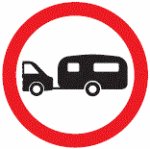The kids have just gone back to school, so now’s the time sensible people can venture out on holiday, and if you’re thinking about taking your accommodation with you then a caravan gives you a lot of flexibility to find amazing slices of English countryside.
First, check that you have the right licence for towing the caravan or trailer you want to tow by looking at our towing licence guide. There are restrictions around the weight of the caravan and the total weight of your towing vehicle plus caravan.
Choosing the right caravan/car combination
Before you buy or hire a caravan you need to know whether your vehicle is capable of towing it. We advise reading this article on guidelines for towing which explains weight limits and classes for different types of towing hitch/tow ball.
When towing, how should you change your driving style?
Caravans come in two types: braked and unbraked. A braked caravan will have brakes on its wheels which are activated when you apply the brakes on your car. Larger caravans are likely to be braked. An unbraked caravan doesn’t have these brakes and will usually be limited to 750kg MTPLM (Maximum Technically Permissible Laden Mass).
Braking
Because the caravan adds forward momentum you will need to brake earlier before intersections and corners, and maintain a greater distance between your car and the vehicle in front. Four seconds gap is a good rule in dry weather, and more if it’s wet or slippery.
Cornering
Load your caravan with heavy items in the centre and on the floor (make sure they can’t roll around, though). This keeps your caravan as stable as possible. You may still need to slow down more for corners, though.
Do your braking in a straight line, before you turn. If you start to turn as you are still braking the caravan will be pushing the rear of your car towards the outside edge of the turn which increases your risk of jack-knifing.
Crosswinds
Caravans are high-sided and light which means they’re more susceptible to crosswinds. Take care on exposed overpasses and bridges, and when you come out of a wind shadow. A wind shadow is shade from the wind caused by a building, trees or a tunnel. A strong gust hitting the side of your caravan as you come out of this wind shadow can take you by surprise and cause you to weave on the road.
Maintenance and checks
During your journey make a habit of quickly checking the coupling and tyres every time you stop for a rest. You will have already checked the rear lights and indicators when you first connected the caravan. You can also check in the caravan to ensure that nothing has moved.
Restrictions
 Some areas are not suitable for caravans and it may be illegal for you to drive a caravan there. These could be narrow dead-end streets or country lanes where it would be difficult or impossible for you to get out if you drove in.
Some areas are not suitable for caravans and it may be illegal for you to drive a caravan there. These could be narrow dead-end streets or country lanes where it would be difficult or impossible for you to get out if you drove in.
Be careful when parking that you don’t exceed the height of the barriers.
Changing lanes
You’re now driving a much longer combined vehicle than before so you’ll need to make sure there’s enough gap for you to move into when you are changing lanes. Because it can take longer to change lanes, move early rather than leaving it until the last minute.
Roundabouts and tight corners
The caravan will follow a tighter path around a corner than the front wheels of your car, therefore you’ll need to take a wider route around the turn so that your caravan’s inside wheel doesn’t run over the roundabout, or that your caravan doesn’t hit something on the inside of the corner.
Blind spots
You will have much bigger blind spots when driving a caravan and therefore it’s important that you adjust your mirrors (and invest in mirror extensions, if necessary). Clear signalling is important to let other drivers know what your intentions are.
Reversing
If you haven’t reversed using a trailer before, be prepared to be embarrassed and for it to take a frustratingly long time. But, with a bit of practice you can get quite quick. Find a large, open area to practice in, e.g. an empty car park or a flat field.
Overtaking
More weight means less overtaking performance. You will be much slower to overtake, and you have a longer vehicle therefore it’ll take more time to overtake, too. A good rule-of-thumb is that after you have finished overtaking you must be able to see 100 metres of clear road ahead of you.
Fuel economy
Your fuel economy will be worse pulling a caravan. Probably much worse. Don’t get caught short in the middle of the Scottish Highlands. Get in the habit of filling up when it’s convenient rather than letting your engine bleed dry.
There are plenty of tips for driving more economically here – it can help you get the most value for money from your caravan trip.
